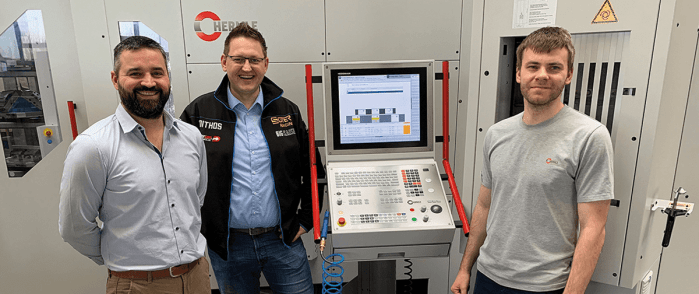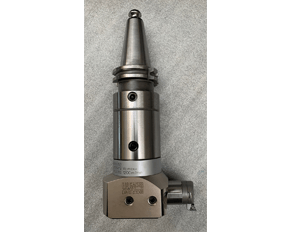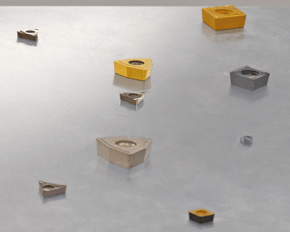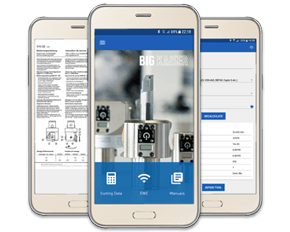Optimization in Everyday Machining Increases Reliability, Efficiency and Tool Lifetime
By using digital technology and optimized indexable inserts, Schmauser Müller Metalltechnik has increased process reliability and efficiency in fine boring, as well as increased the lifetime of its tools by a factor of three.
Schmauser Müller Metalltechnik, a Bavarian-based CNC manufacturing company, produces individual parts or small series from all materials with high precision and flexibility. Its service portfolio is rounded out by fixture construction, metal technology and associated CAD design.
"As a Bavarian company, we naturally serve automotive manufacturers," says Production Manager, Rainer Maurer. "However, to limit our exposure to fluctuations in the car industry, we maintain a diverse customer base.”
“For example, for one start-up company, we are manufacturing an innovative feeding technology. Instead of a repetitive manual process that frequently leads to unpredictable results, we've simulated the most complex conveyors, and we’ve been able to manufacture a custom-fit solution precisely to the customer's requirements. This approach has also succeeded for our own internal processes. with BIG DAISHOWA we have optimized our fine boring division on two levels simultaneously."
The Digital Twin: state-of-the-art technology for a perfect process
"Our first project was the digital twin, which is a virtual model of a real-world process, object or system," Maurer says. "It ensures that the user can be sure of success even before the actual process begins. Digital twins are particularly useful for one-off parts, since there is no previous data available, and the part must be made right the first time.”
At SM Metalltechnik, the company’s process uses HSM Works CAM software from Autodesk, where a digital twin is created for all relevant components. In this case, this is for the 5-axis simultaneous milling machine C42 from Hermle with HS-Flex automation and for the clamping devices from SMW Autoblok.
The tools themselves also are digitally reproduced; in particular the fine boring heads with adjustable projection lengths and diameters. Key details, such as the Blum laser measuring system, must also be considered, to avoid any collision with the tool measuring system or other objects.
After all the components are depicted, it is possible to simulate the best program sequence on the computer. This is particularly applicable for complex 5-axis simultaneous machining tasks where it is often impossible to continuously monitor all of the relative movements. A miscalculation in this area, for example a collision, could prove fatal for the entire business process.
"A truly professional process must run reliably: first time, every time. Some time ago, a colleague of mine urged me to introduce the digital twin at our company. Today, we routinely run our parts through the simulation and have full confidence in the final results. This process ideally complements our modern machinery," says Maurer. "Luckily, our Hermle machine was digital twin ready, although we sometimes failed because we lacked precise complexity parameter data. This led to unpredictable results, since each extension combination has a different digital twin. To overcome this, BIG DAISHOWA provided us with the required data for all the relevant lengths and diameter combinations."
Getting out of the indexable insert jungle
Digitization was not the only factor that contributed to SM Metalltechnik's growing success in the fine boring process. Alexander Hartl, an application engineer at BIG DAISHOWA, also substantially contributed to this improvement with the right indexable insert, an often-overlooked detail that makes everything easier and more efficient.
"Having used many different cutting materials in the past, we were not sure which one was best suited to a particular project," recalls Maurer. "Our guesswork often resulted in inserts breaking and unsatisfactory results. Not surprisingly, our employees became reluctant to take on fine boring work. This has all changed. Today, we have a total of just 11 inserts at our facility, each for a clearly defined task and purpose."
Hartl says, "I analyzed SM Metalltechnik's requirements with Rainer Maurer in great detail. Based on the information, I was able to reduce the number of indexable inserts to 11 and still cover all the material and diameter combinations."
Maurer adds, "Our employees now have full confidence in the process. Our state-of-the-art, automated machining can run unhindered, dimensional accuracy is constant and surface quality is perfect. In short, this improvement in our processes has enabled us to exploit the full potential of our existing machines.”
App for conveniently optimizing cutting parameters
"Most companies rely on cutting data that someone has already generated," says Maurer. "Typically, an apprentice would ask their boss what to enter, who would then give a figure off the top of their head. These handed-down values would then haunt the company for many years. This approach wastes a lot of potential and has negative effects on machining speed, quality of the results and tool lifetime. This no longer applies to us."
Progress was made possible by the research and development department of BIG DAISHOWA, where the optimum cutting values are determined through painstaking precision work to prolong the service life of inserts. These tests are extensive due to the many influencing variables: every diameter, every material and every projection length have an impact on the result. The same applies to the different spindle types. The BIG KAISER app makes the results of these tests available to the user, enabling them to fully concentrate on their core business.
"Our fine boring process, in conjunction with CAM programming, now runs as follows: we enter the desired parameters in the app, such as bore diameter, material and projection length. The app then tells us which of our BIG DAISHOWA tools is to be fitted with which insert, which extensions may be required and what cutting data is to be set,” Maurer says. “Then we select the corresponding digital tool twin on the CAM workstation and program in the cutting values. That's it. The operator no longer has to experiment with different values, but can rely on the results generated by the app, which simplifies the process enormously."
Maurer continues, "The lifetime of our tools is now three times longer than before. More importantly still, we replace inserts after a pre-defined period of use, instead of waiting until they no longer fit, and only changing them when something goes wrong.”
How does the concept work?
Every year, BIG DAISHOWA invests hundreds of hours in the development and testing of new inserts, with a particular focus on fine boring. Even better results are achieved by further optimizing the company’s own fine boring heads in-house. BIG DAISHOWA has already patented important details, such as the optimized chip groove which optimizes chip removal and thus the surface quality of the finished bore - a distinctive quality feature of the company’s fine boring solutions.
The focus on fine boring clearly differentiates BIG DAISHOWA. Other manufacturers produce a specific insert for a specific application, which works well for precisely that purpose, but performance deteriorates as soon as the given conditions are altered. For companies that produce small series runs or individual parts, this results in a large number of bores and materials. It forces them to use a hundred or more different indexable inserts to achieve the best possible results. This is quite a burden since the user needs to have all tools on hand at the workshop, and use them at the right time, with the right cutting data. While other indexable inserts can often do the job, they achieve lower precision and uncertainty.
The BIG DAISHOWA concept aims to avoid such a scenario. Instead of focusing on excessive specialization to achieve marginally better results, BIG DAISHOWA has created a universal insert for delivering outstanding results in real-world manufacturing environments. The result is reliable, efficient and highly precise workmanship.
Well positioned for the future
The potential of such optimization is huge, whether with the help of digital technology or with suitable inserts. At SM Metalltechnik, these new fine boring processes have proven themselves a success across the board. The company benefits from BIG DAISHOWA's know-how that has been developed and acquired over hundreds of hours of tedious work and puts it into practice each and every day on the shop floor. SM Metalltechnik is, therefore, exceptionally well positioned for the future.
Did you find this interesting or helpful? Let us know what you think by adding your comments or questions below.









Add new comment